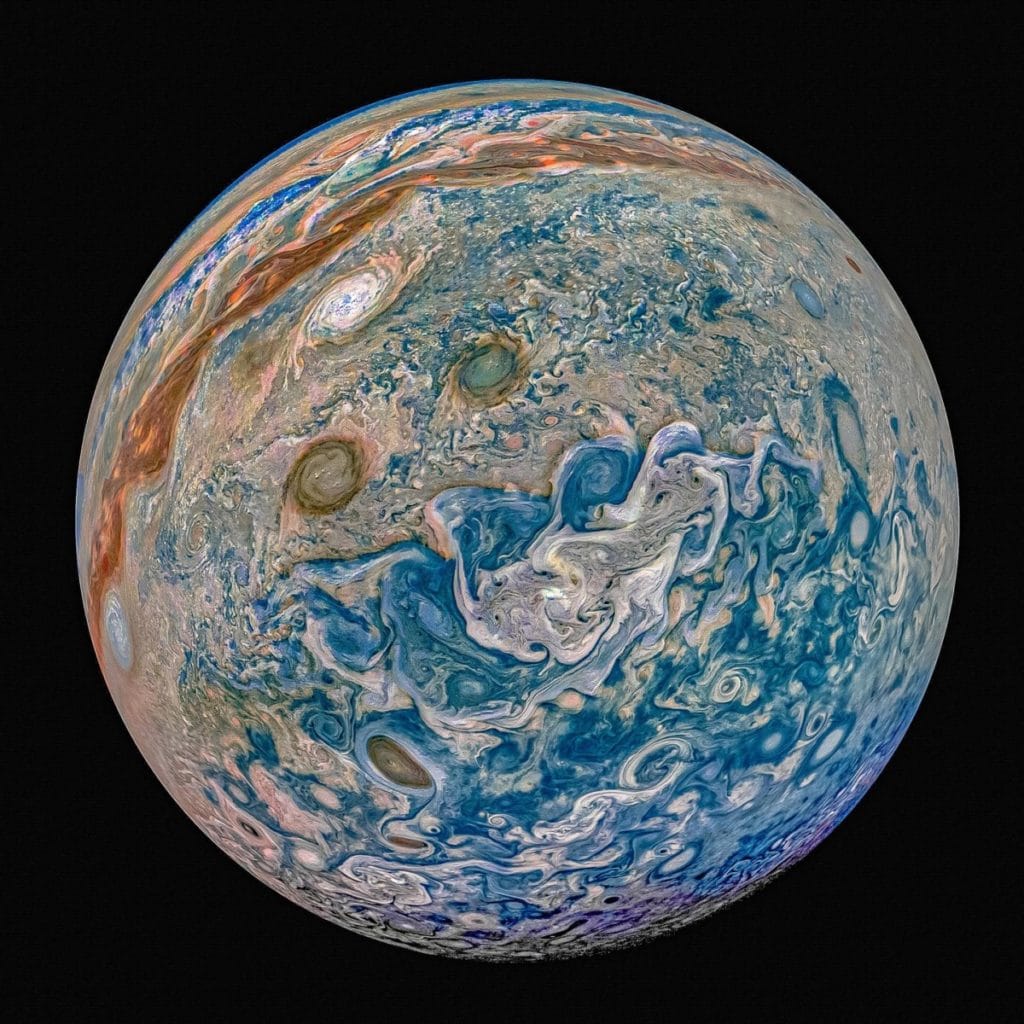
Image by NASA/JPL
For those of us living a carefree life away from the dangers of the cosmos, we might only recognize Jupiter as something resembling a striped patterned marble with a reddish spot. And in all honesty, that’s enough knowledge to get by with our current development in space technology. But for those with an inquisitive mind, there is more to this gas giant than meets the eye.
Jupiter, as the oldest planet of the solar system, took seniority in helping scientists to discover the origin of the universe. The information we have gathered not only helped us understand why Jupiter looks like a giant marble, but also the discovery of hurricanes, lightning storms, active volcanoes, and the possibility of planet-like worlds existing on Jupiter’s Galilean moons.
There are with no doubt more to Jupiter than our technology is able to detect. But until we can, let’s learn of the secrets we have already unveiled.
Why is Jupiter called a Jovian planet?

Jupiter, or otherwise known as Jove, in Roman mythology is the king of the gods and the god of sky and thunder. The term Jovian would then describe those that are similar to the god Jove.
In an astronomical sense, Jovian follows the same logic, which relates to the planet Jupiter, as well as the class of gas planets that Jupiter belongs to (Oxford Languages). This includes Jupiter, Saturn, Uranus, and Neptune. The general structure of the Jovian planets is opposite those of the terrestrial planets, which include, Venus, Mercury, Earth, and Mars.
As gas giants, the Jovian family are much larger, have no solid surfaces, and have cores that consist of a mixture of rocks, metal, and hydrogen compounds.
How did Jupiter Get Its Appearance?
If someone asked you what Earth looked like from outer space, what would you tell them? Quite simply, you might say we are a planet of blue, green, and white, with landmasses and swirls of clouds across the globe. And this is all possible because the Earth’s atmosphere is transparent to visible light.
Similarly, what we see of Jupiter are the elements that make up most of its atmosphere and clouds. Although, due to the lack of a well-defined solid surface, atmospheric gases are the only things we see.
Each layer to Jupiter’s atmosphere has a characteristic temperature gradient that determines its composition. And the visible cloud layer that forms the bands of Jupiter belong to the lowest layer – the troposphere.
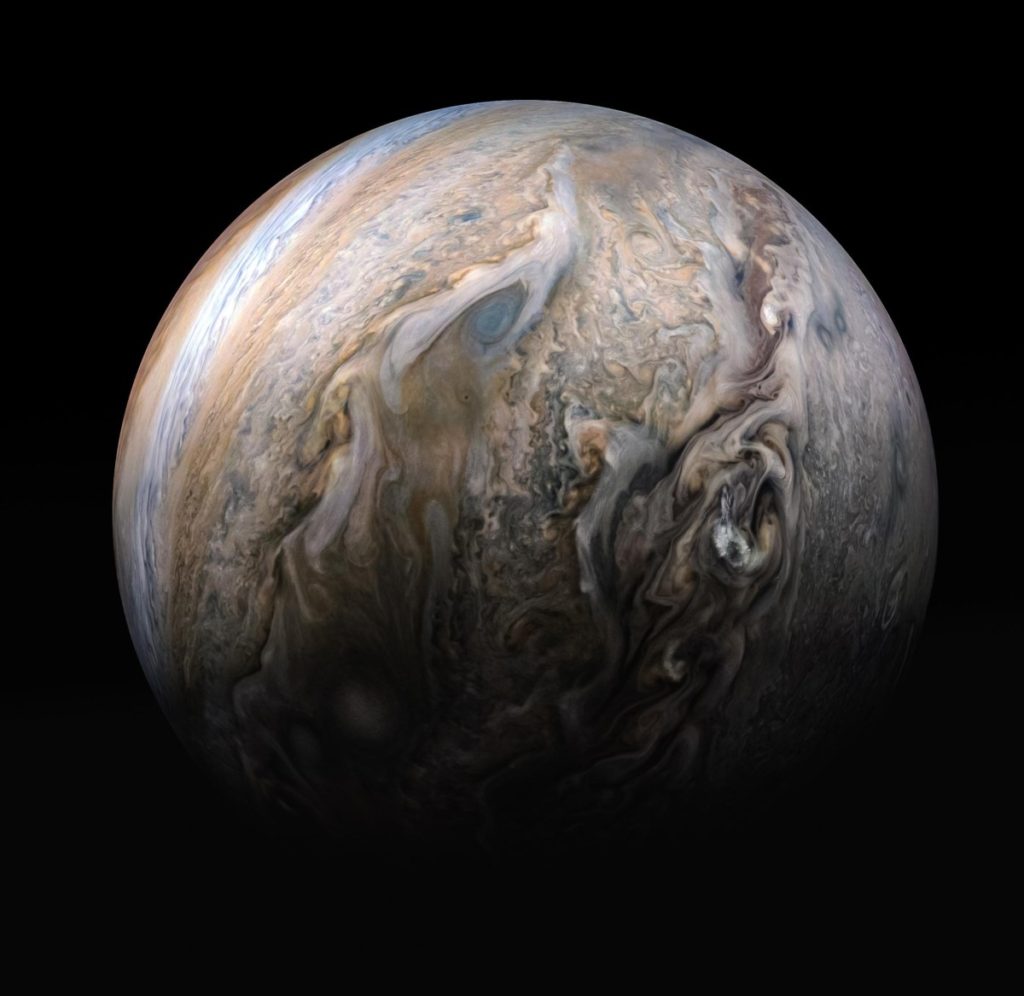
Image by NASA/JPL
The troposphere is comprised of a complicated system of clouds and hazes, which is formed from layers of ammonia, ammonium hydrosulfide and water. There is strong evidence to suggest ammonia ice as the material of Jupiter’s visible cloud layer. With the exception of relatively dry regions such as belts and hotspots, these clouds are present everywhere (1).
Organized in zonal bands that are parallel to the equator, the movement of the visible clouds are bound by powerful zonal atmospheric winds known as jets.
Dark Bands – The dark bands we see are called belts, which represent relatively dry and downwelling regions (descending gas) where the cloud locations are expected to be similar to those in the hot/warm spots.
Light Bands – The light bands we see are called zones, which quite opposite to the belts, are representative of colder temperatures, and correspond to upwellings (ascending gas). The zone’s lighter colors are believed to be the result of ammonia ice.
The difference in the appearance between zones and belts are characteristic of its chemical composition. At cooler, higher altitudes, there are denser clouds of ammonia ice that contains a higher ammonia concentration, leading to the zone’s lighter color. On the other hand, the clouds of ammonia ice are thinner at a lower altitude, which may have resulted in the band’s darker color (we need more data!). The exact composition of the bands is not known, but their multitude of colors may be due to a mixture of sulfur, phosphorus, and carbon.
Thunderstorms and The Great Red Spot
Lightning
“In October and November of 1997, the Galileo Solid-State-Imager (SSI) detected lightning from 26 storms on the night side of Jupiter. The data included images of lightning against moonlit clouds (illuminated by light from Io) and images of the same storm on the day and night side.” (3)
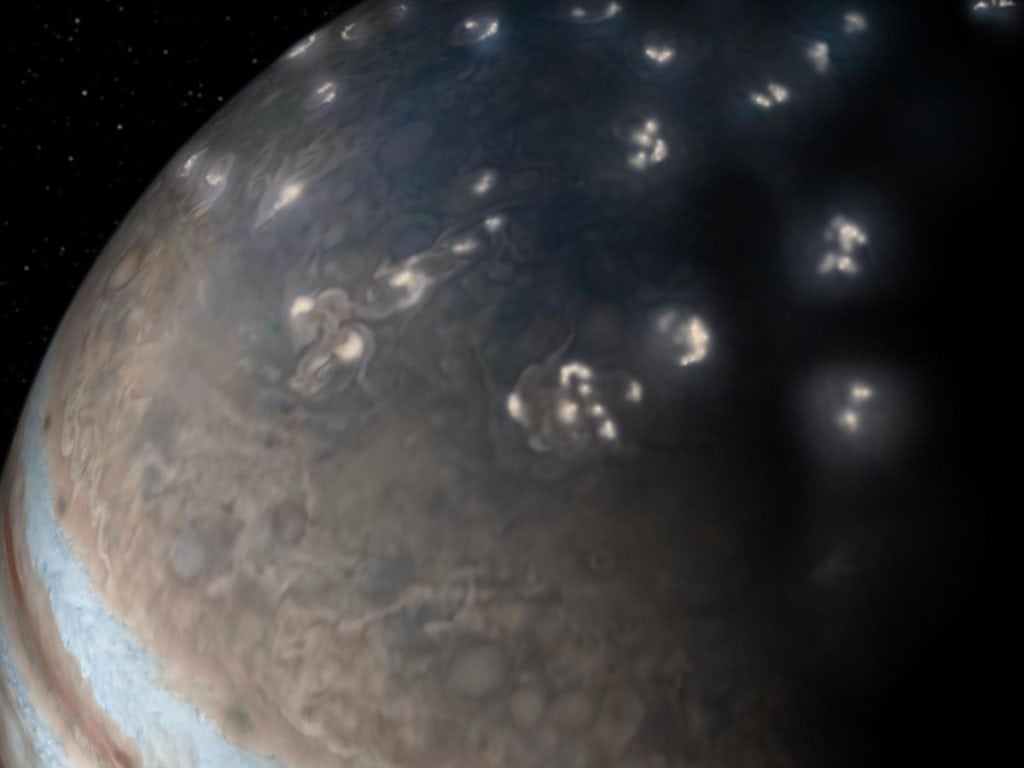
This artist’s concept of lightning distribution in Jupiter’s northern hemisphere incorporates a JunoCam image with artistic embellishments. Data from NASA’s Juno mission indicates that most of the lightning activity on Jupiter is near its poles.
Image by NASA/JPL-Caltech/SwRI/JunoCam
Lightning on Jupiter first of all is just super cool. We wouldn’t normally think of such an earthly phenomenon to occur on a planet without a solid surface. And that’s what makes this so interesting.
Lightning is an electrical current charged by the collision of small bits of ice (could be frozen raindrops) that bump into each other within a thundercloud. When the cloud is fully charged, it connects with the positive charge on the ground (on Earth) and – zap – lightning strikes! (Weather Wiz Kids)
This is important as lightning suggests the presence of moist convection, which regards to the enthalpy (energy) exchange between condensing water vapor or freezing liquid water and air – the formation of clouds! The manifestation of clouds would require an abundance of water, which becomes critical to the theory of Giant Planet formation – a popular theory for the formation of giant gas planets. This theory argues that the rock-and-ice cores of the gas giants are gradually formed through the coagulation of smaller planetesimals (objects formed from dust, rock, and other materials) until they were massive enough to accrete gaseous envelopes.
The Great Red Spot

Aside from being the big brother of the solar system, Jupiter is also famously known for the Great Red Spot, consisting of the largest anticyclonic storm in the solar system with wind-speeds up to 432 km/h (268 mph).
This phenomenon exists in the southern hemisphere of Jupiter’s ever-changing surface of clouds. Being elliptical in shape, its mean radius is approximately 70,000 km – so wide that it can fit about three Earths within its boundaries!
The reddish coloration of the planet and the Great Red Spot have been hypothesized to be a result of Phosphine that was discovered in the atmosphere of Jupiter.
A chemistry and photochemistry study of the phosphine later suggested this red coloration to be a result from the photochemical production of red phosphorus particles. “The chemical-dynamical models of this red phosphorus haze imply that the intensity of the red coloration is a strong function of the strength of vertical turbulent mixing in the atmosphere” (2).
What makes this storm so mysterious lie in the fact that its first official observation started in 1831 by the amateur astronomer Samuel Heinrich Schwabe, but it’s believed that back in 1665 when the astronomer Gian Domenico Cassini wrote about a “Permanent Storm”, he was referring to the exact same Great Red Spot. (Space) Due to the gap between and lack of observations, it is not sure whether the storm had simply dissipated and reformed or had existed long before humanity looked up to the skies.
The first detailed image we received of the Great Red Spot was transmitted by Voyager 1 on the 25th of July 1979, where the spacecraft was 9,200,000 km (5,700,000 mi) from Jupiter. The Juno space probe, which has been in orbit around Jupiter since 2016 will continue to help us observe and collect data regarding the composition and evolution of the Great Red Spot and Jupiter’s atmosphere.
Does Jupiter have a magnetic field?
Due to the efforts of Pioneer 10, scientists were able to make numerous conclusions about Jupiter, which includes the discovery of a magnetotail (an extension of a magnetic field). Although similar in structure with a north and south magnetic dipole, Jupiter’s magnetosphere is 20,000x stronger than Earth’s, extending up to 7,000,000 km in the sun’s direction.
Due to its size and strength, Jupiter’s magnetic field traps charged particles from the sun and averts the solar wind almost 3 million kilometers before contact. This results in the creation of a deadly radiation field that will cause wreckage to even exploration spacecrafts without radiation shielding. But this is not without its benefits. Such a magnetic field also helps shield the inner solar system from possible asteroid impacts, truly making Jupiter the “big brother” of the solar system.
Jupiter and the Origin of the Solar System
Jupiter was not always the obedient and protective “big brother” as it appears today. After its formation in a region of space 3.5 times as far from the sun as Earth (3.5 astronomical units), which was long before it settled in its current position as the fifth planet from the sun, Jupiter roamed towards the center of the solar system – to a point as close as where Mars would be today (1.5 astronomical units), before coming back out again.
Carried on currents of swirling gas, Jupiter was not traveling alone. Saturn had decided to tag along for the journey. “When the two giant planets came close enough to each other, their fates became linked.” (NASA) Avi Mandell, a planetary scientist at NASA Goddard theorized that “Jupiter had stopped migrating towards the sun because of Saturn.”
When all the gas between the two planets was expelled, their death bound journey to the center of solar system was brought to a halt, and eventually began its return journey in the opposite direction. The two planets stayed together until Jupiter reached its current position today (5.2 AU) and Saturn at about 7 AU, until it was later pushed out to its current location at 9.5 AU.
Astronomers gave the name “The Grand Tack” to the path Jupiter had taken, which was in reference to a sailing maneuver of a course that a sailboat takes when it tacks around a buoy.
This travel itinerary influenced immensely the solar system, changing the nature of the asteroid belt and making Mars smaller than it should have been. (NASA)
The Asteroid Belt
The existence of the Asteroid Belt in between the orbits of Jupiter and Mars was theorized to be wholly dependent on Jupiter’s Grand Tack maneuver. It provides a plausible explanation as to why the asteroid belt is made of both dry, rocky objects and icy objects.
During its journey, Jupiter’s gravity prevented the rocky material that makes up the asteroid belt today from coming together to form a planet. Instead of destroying the asteroid belt as it moved towards the sun, Jupiter essentially performed a do-si-do by deflecting the objects and switched places with them. (NASA) In the same manner, Jupiter’s trip away from the sun nudged the asteroid belt back to where it rests today. But because Jupiter had traveled much farther out than it had been before, right into a region where icy objects can be found; this gas giant deflected some of the icy objects towards the sun and into the asteroid belt.
The Formation of Mars
If not for Jupiter, Mars would have grown up big and strong, and definitely not like its tiny self today.
Due to the presence of Jupiter in the inner solar system, much of the materials required for making planets had been scattered. In theory, because Mars had formed farther out than Venus and Earth, it should have had a lot more raw material to work with and resulted in a much bigger planet.
“Knowing that our own planets moved around a lot in the past makes our solar system much more like our neighbors than we previously thought. We are not outliers anymore.”
Kevin Walsh
Jupiter’s Galilean Moons
As the largest planet of the solar system, Jupiter surprisingly lost out to its neighbour Saturn in competition for the planet with the most moons. A recent discovery of 20 new moons orbiting Saturn brought its total up to 82, whilst Jupiter came up three short with only 79 natural satellites (moons).
Despite losing out on quantity, the “quality” of Jupiter’s moons is not to be taken lightly. Astronomers have kept an observant eye on the largest of Jupiter’s moons since 1610. Named after the Italian astronomer Galileo Galilei, the four Galilean moons – Io, Europa, Ganymede, and Callisto were the first objects found to orbit a planet other than our own moon.
The Galilean moons have received special attention over the years not only because of their size, but what’s on their surface.
Io
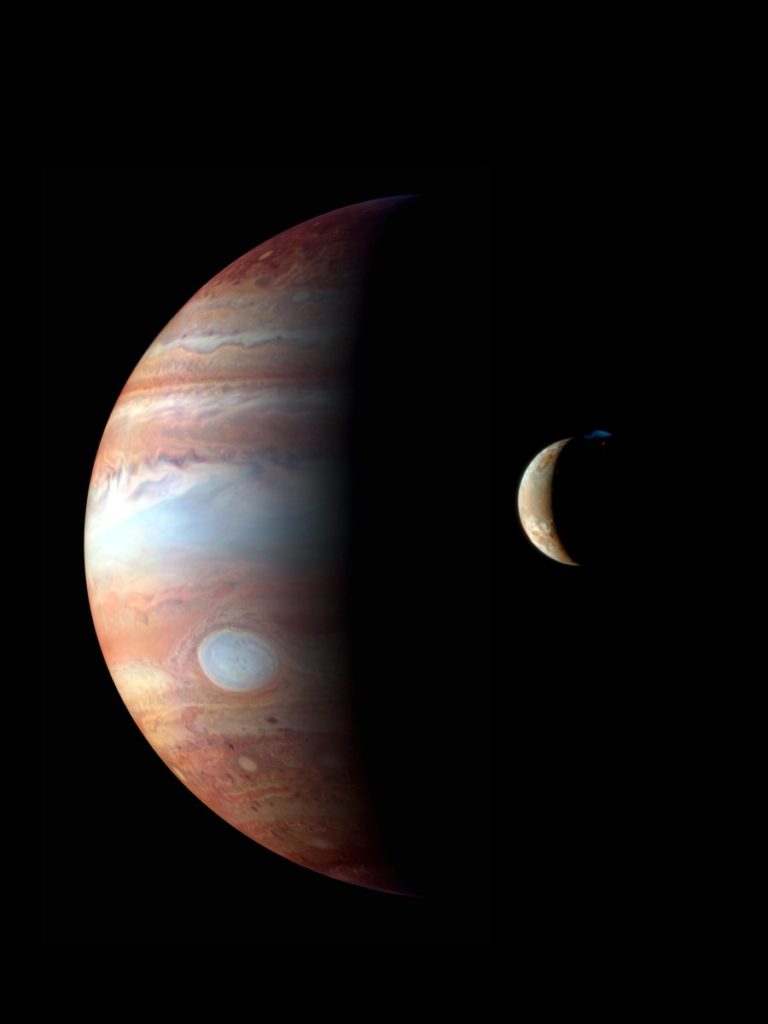
Io is the most volcanically active body in the solar system with over 400 active volcanoes. This bizarre volcanic activity is drive by Io’s slightly elliptical orbit, at which Jupiter’s immense gravity causes tides in Io’s solid surface of over 100 meters (300 feet) high. Such tides generate enough heat to give rise to the volcanic activity driven by hot silicate magma. (NASA)
The volcanoes on Io are at times so powerful they can even be seen on Earth with large telescopes.
Europa

Europa’s Stunning Surface 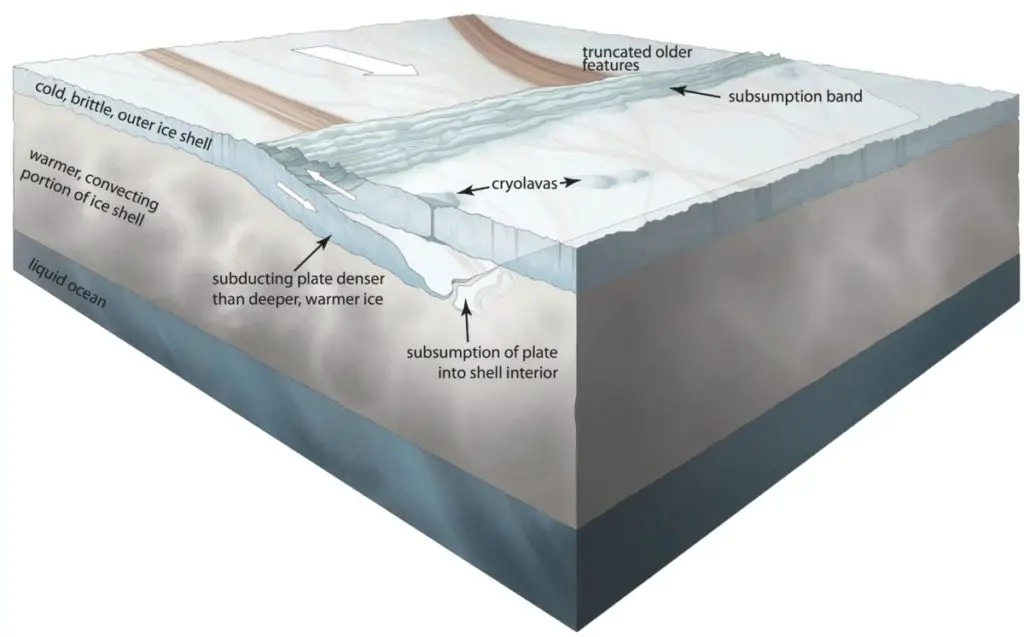
Plate Tectonics on Europa
Europa is perhaps one of the most prime targets for observation even out of the four Galilean moons. The surface mostly water ice and the icy crust is believed to cover a global water ocean. Scientists think Europa’s ice shell is 10-15 miles (15-25 km) thick, floating on top of an ocean 40-100 miles (60-150 km) deep.
The amount of liquid water on Europa is thought to be twice the amount on Earth despite having only ¼ the diameters of Earth. And for comparison, life forms have been found to thrive near underwater volcanoes on Earth, which may be up for consideration as to what may exist on Europa.
In November 2019, a NASA led international research team for the first time directly detected water vapor above Europa’s surface. If such plumes exist, it is possible for us to send a spacecraft that could sample and analyze it from orbit.
As we know it, where there is water, there is life.
Ganymede
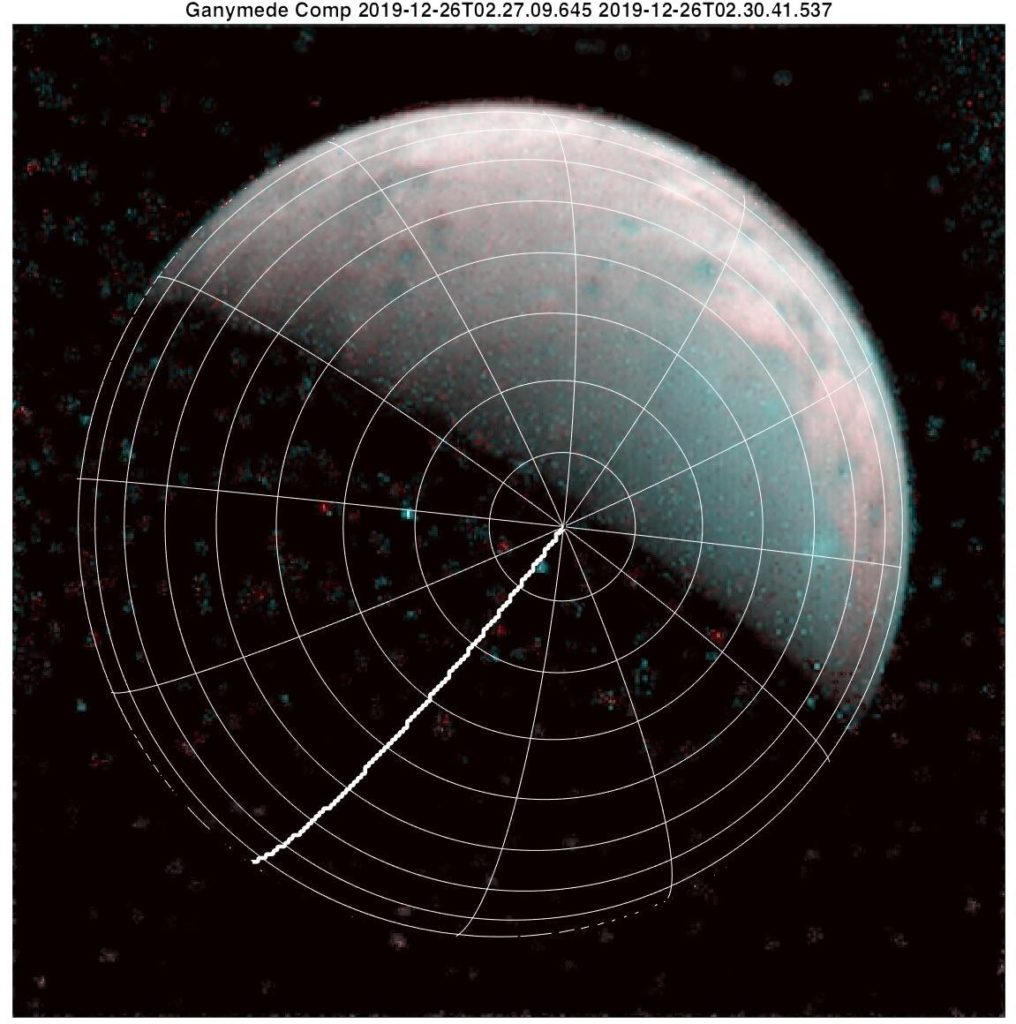
Ganymede’s North Pole with Gridlines 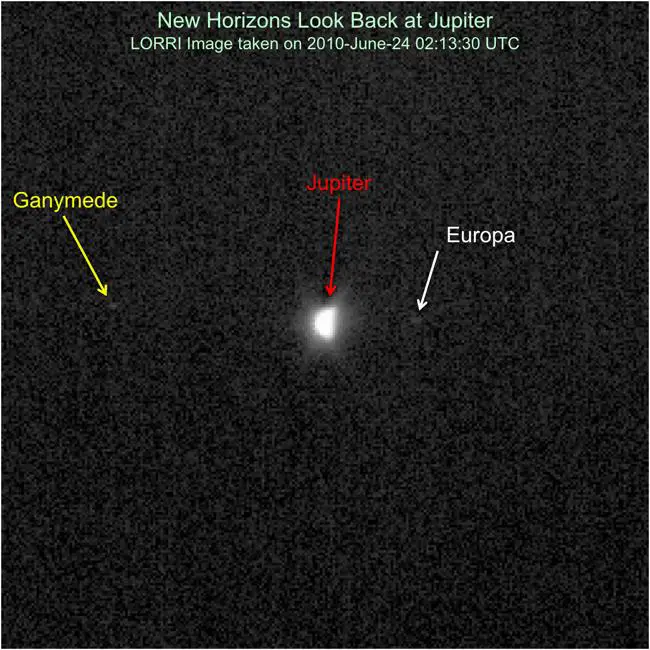
LORRI Looks Back
If Jupiter is the big brother of the solar system, then Ganymede is no doubt the big brother for the moons of the solar system. Ganymede is so big it’s even larger than the planet Mercury!
Out of all the moons, Ganymede is the only moon known to have its own internally generated magnetic field, which is thought to be the product of convection within its liquid iron core. There has also been strong evidence of an underground ocean below its ice surface/shell.
Similar to Earth, the magnetic field of Ganymede also causes auroras – ribbons of glowing, electrified gas, in regions circling the moon’s north and south poles.
Callisto
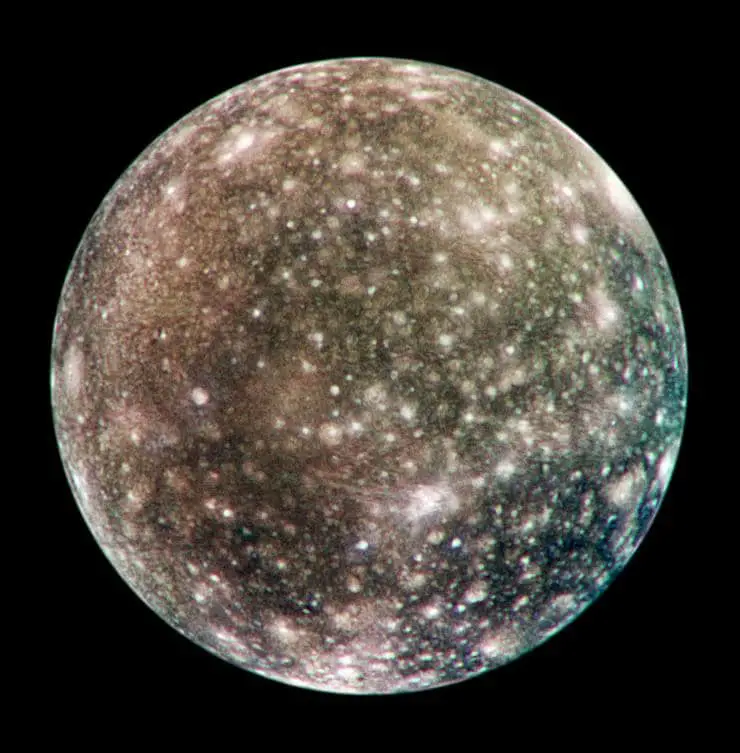
Image by NASA/JPL/Galileo
Callisto is Jupiter’s second-largest moon and the third-largest moon of our solar system with a size similar to that of Mercury.
Compared to its satellite friends, Callisto is often thought of as the “ugly duckling moon” and a “hunk of rock and ice” as its surface is ancient and extremely cratered, which might show a record of events from the early history of the solar system.
You can probably already tell from its nicknames, Callisto is really nothing special, but NASA’s Galileo spacecraft in the 1990s might reveal otherwise. Data from the probe show that there is the possibility of a salty ocean beneath its surface, which puts the “hunk of rock of ice” on the list of worlds that could possibly harbor life. (NASA)
References
- Atreya, S. K., & Wong, A.-S. (2005). Coupled Clouds and Chemistry of the Giant Planets— A Case for Multiprobes. Space Science Reviews, 116(1–2), 121–136. https://doi.org/10.1007/s11214-005-1951-5
- Prinn, R. G., & Lewis, J. S. (1975). Phosphine on Jupiter and Implications for the Great Red Spot. Science, 190(4211), 274–276. https://doi.org/10.1126/science.190.4211.274
- Little, B. (1999). Galileo Images of Lightning on Jupiter. Icarus, 142(2), 306–323. https://doi.org/10.1006/icar.1999.6195
